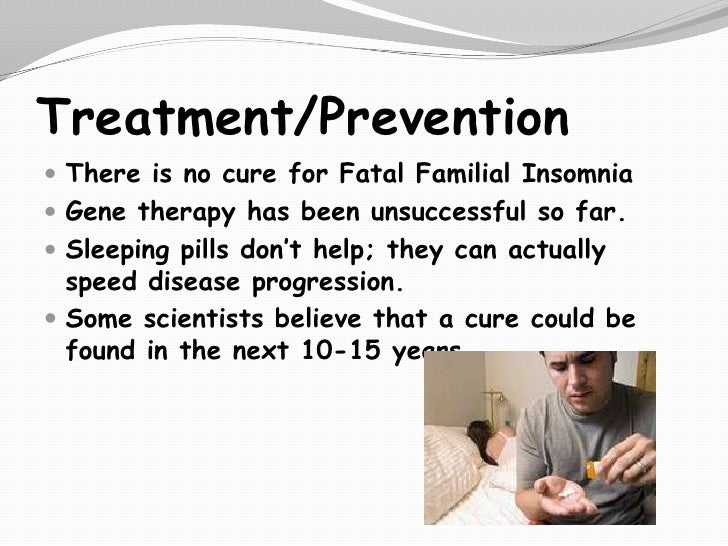

A full cycle takes about 90-120 minutes and is repeated 4-6 times per night. In a healthy person, during sleep the brain cycles from relatively light sleep into a period of deep sleep into a period a rapid eye movement (REM) sleep. Polysomnography reveals, however, that their brain activity doesn't resemble a pattern of normal sleep. Polysomnography is often used to verify a case of fatal insomnia because patients may appear to spend periods of the night sleeping, as they have their eyes closed and aren't moving. Polysomnography measures the electrical activity in the brain (using an electroencephalogram, or EEG) along with a number of other physiological changes that occur during sleep like eye movement, muscle activity, and the electrical activity of the heart. One way to verify the sleep disturbances occurring in fatal insomnia is to measure sleep activity over the course of a night using a technique known as polysomnography. What happens in the brain in fatal insomnia? Brain activity during "sleep" The duration of the disease ranges from 8 to 72 months, with an average disease course lasting just over 18 months. He may lose the ability to speak, have trouble swallowing, and fall into a vegetative state.ĭeath can occur at any time throughout these phases of the disease, but if the patient survives long enough often he will fall into a coma, which will lead to death. He may experience sudden, spasmodic movements, but voluntary movement like standing and walking often become difficult to impossible. Later in the disease, after a patient has been deprived of sleep for some time, he begins to spend more and more time in a stupor from which it's difficult to rouse him. Patients also will sometimes become delusional and display unusual behavior that resembles dream-enactment, which involves unconsciously making movements related to what's going on in a dream. A variety of movement problems appear, including difficulties with balance and coordination and abnormalities in gait. Sometimes there are other abnormal signs early on, like double vision, impotence, hypertension, and increased perspiration, lacrimation (i.e., tear production), and/or salivation.Īs the disease progresses, patients lose their ability to sleep altogether. At first, due to this extreme daytime sleepiness, the assumption might be that the patient is plagued by a condition that is making him too sleepy. When he died, he had essentially been awake for 6 months.įatal insomnia is a rare disease that usually develops in middle age or later (the average age of onset is 51 years), and begins with complaints of trouble sleeping or excessive fatigue during the day. By the time he had been admitted to the hospital, about 130 days had passed with minimal sleep. In the disease, sleep becomes progressively disrupted until patients exhibit little to no sleep. This helped doctors to realize that he was suffering from a disease that had only been recognized within the previous decade, called fatal familial insomnia (now often called fatal insomnia because not all cases seem to be hereditary). They diagnosed him with multiple sclerosis, despite the fact that he didn't really have the symptom profile of someone with the disease.īut doctors soon recognized that something was very unusual about Corke's "sleep." Even though Corke would often close his eyes and appear to be sleeping, measurements of his brain activity found that his brain never did actually fall asleep. His decline had been rapid and pervasive.Īt first, doctors could not figure out was wrong with Corke. He had become completely dependent on his family to help him perform even the simplest tasks like showering and getting dressed. At that point, Corke was unable to communicate.


Sometimes these episodes involved hallucinations.Īfter Christmas, he was admitted to the hospital. He began to display signs of dementia and there were times when he appeared to lose touch with reality. He developed problems with balance and had trouble walking. Within a few months, Corke's lack of sleep was causing obvious physical and mental deterioration. Nor was he suffering from the common problem of waking up frequently over the course of the night. It wasn't just taking him longer to fall asleep than normal. He had recently turned 40, and seemed to be in good health, but it was soon very obvious that he was suffering from more than just your run-of-the-mill insomnia. Corke was enjoying the summer break from his position as a music teacher in a Chicago high school when he started to develop sleeping problems.


 0 kommentar(er)
0 kommentar(er)
